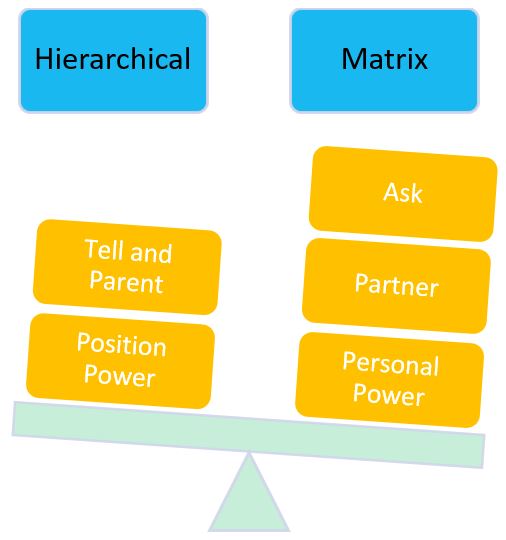Date Published August 20, 2020 - Last Updated December 10, 2020
Where did the concept of management come from?
I remember Daniel Pink saying in his TED talk, The Puzzle of Motivation, that management is a relatively new idea and did not stem from nature.
I also remember thinking; I know where it stems from and it is NOT a new concept. Funny enough, what we know as “management” in today’s world came from the Bible, specifically the book of Exodus. Who knew!
It has to do with Moses being overwhelmed attempting to “herd cats” with over a million Israelites as they left Egypt. Moses’ father-in-law, Jethro, says to him, “Hey, why don’t we try this, so you don’t have to do everything yourself?” Obviously, a lesson in delegation
Jethro suggests four levels of management:
- Over Thousands
- Over Hundreds
- Over Fifties
- Over Tens
And this style of management similarly lingers today in our world. Well, until the matrix!
The matrix-style of an organization has nothing to do with management in that form. Digital Equipment Corporation, which was at the time the second-largest technology maker after IBM, thought it would be a fun experiment to try a matrix management approach. There were many types of matrix management models that they attempted. It didn't work. Nokia decades later attempted a matrix management 2.0. "Leading without an authority" or "No one functional leader is in charge.” That seems to be a trend in our market today. Why?
The why can vary depending upon point of view and who you talk to, yet essentially, it helps to avoid stopgaps and silos, especially when rolling out a new product. And in some companies, it has been applied to IT as well!
One of the companies where it seems to have worked the best is Gore-Tex. And as far as my expertise can tell, the company’s values are “Belief in the individual to do what's right for the company” and “Freedom to get the job done as they see fit.” Those are the core motivations of that company. They have proven that it works and are slotted for awards all the time for their innovation, pace in the marketplace, and best places to work.
So, what happens when you are used to the traditional style of management, and all of a sudden you are thrust into this seeming chaos where no one person is in charge? Well, my friend, it is a whole different skill set that needs to be in place so that you are comfortable and know how to make the most of that matrix.
What happens when you are used to the traditional style of management and all of a sudden you are thrust into this seeming chaos where no one person is in charge?

In a matrix environment you will find:
- Less structure
- More ambiguity
- Responsibility with limited authority
- A whole new strategy to learn
To be successful in that space, consider this. You will want to develop the following:
- EQ competencies
- Specific skills associated with those competencies
- Capabilities of the skills you develop (the how to)
As a Master Emotional Intelligence Practitioner, I have identified the competencies that I feel would be the most important to build within yourself to survive and thrive in the matrix. Here they are with the associated skills listed under them:
Empathy: Understand and feel perspectives and mindsets
- Understand when to use different listening types
- Inquiry Skills—learn to ASK questions, not to TELL people what to do
Flexibility and Adaptability: The ability to bend and not break
- Learn how to be less reactive and more responsive
Emotional Self Awareness: Intention vs. Impact
- Only 9% of employees demonstrate self-awareness consistently according to HBR
- Slow it down—slow yourself down
- Dial into your “self”—emotions are Information
- Manage “self”—speak out and be real but kind
- Check it before you wreck it!
Authenticity: Be real and true to who you are internally
- The result is trust is easier to build
These are the capabilities of collaboration you need to thrive in a matrix organization:
-
Overcome the Fear of Conflict: Avoiding conflict is failing. Incorporate
feedback and coaching, but partner with your people, do not parent them.
-
Personal Power: How you influence people. Learn what is important to them and help them achieve that.

Whatever you think of this or any new style of organizational structure, one thing is clear. People have had it with being bossed around and pushed into a corner. Command and control don’t work anymore. Companies that take that stance are losing ground and market share.
Everything changes and when that time comes, we need to have been proactive in our approach to make ourselves ready for whatever the future holds. Things can change slowly, and sometimes the turns are sudden and without notice. As an individual, you and I can be prepared in ourselves by mastering those very important aspects that will be viable in any environment.
For more than 15 years, we have had the technology and process to work successfully from home. We simply didn't work in companies that had the trust or culture to allow that to happen. Remember March 2020? And just like that, it all changed! My encouragement? Be ready to maneuver through the matrix. Times they are a-changin’!
Deborah Monroe is one of 18 Master EQ practitioners in the world, through the Global EQ Community of 6 Seconds. She's also an associate with the Institute for Organizational Performance and an HDI business associate. Working with all levels of executive leadership, management, and individual contributors, Deborah concentrates on integrating humans and process to create a balanced working environment. Her aim is to build understanding and empathy, creating a positive bottom line through employee and customer retention.